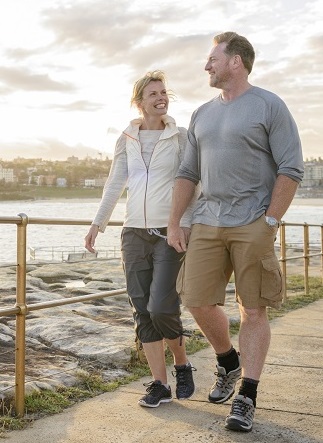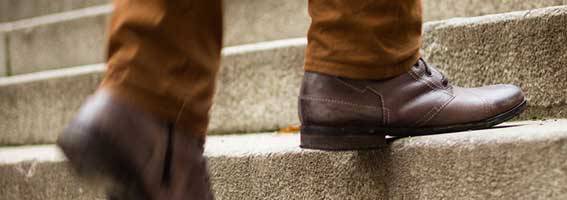How we age: health and wellness as we get older
October 2022
Last reviewed by Manulife on October 2022.

Prior to joining SickKids, Dr. Apkon was Chief Medical Officer for the Children’s Hospital of Philadelphia (CHOP) and Executive Director leading Yale-New Haven Children’s Hospital. He is currently a Professor of Paediatrics at the University of Toronto and has held faculty positions at University of Pennsylvania, Yale School of Medicine and Yale School of Management.
The following article was written by Dr. Michael Apkon, President & CEO of Toronto’s SickKids hospital, as part of an exclusive series on wellness. His first piece focuses on how we age and steps we can take to control our quality of life as we get older.
A long, happy, and healthy life is, perhaps, our most fundamental aspiration. Many of us put significant thought into planning a path that keeps us vigorous and active as we move along the arc of our lives. Increasingly, science is demonstrating that the choices we make, and the actions we take, have considerable influence on how successful we are at living a healthy life.
As a pediatrician and a parent, I consider how to set children on the best possible path to life-long health. As a healthcare executive, I consider how traditional healthcare services promote health. As a taxpaying citizen, I consider how individuals and society can promote health and wellness. And, as the son of aging parents – and someone well into middle-age myself – I consider how to preserve vigour and forestall the inevitable consequences of aging. All of these perspectives take into account the relative impact of environment, biology, and other factors that influence health and wellness.
The likelihood of illness and progressive disability is a predictable consequence of getting older. However, the speed at which our health declines as we age is highly variable from person to person. This variability is determined by a number of factors, including many that are within our control. Whereas aging is inevitable, the way we age and how we remain healthy is, to some degree, optional.
Health is about more than the absence of disease. Rather, being healthy is about being ready and able to participate in the activities and challenges of daily life. Emerging medical concepts recognize that “complete well-being” needs to be considered for an individual given their age, chronic disability and other factors. For most of us, the functional aspects of health – having the ability to do the things that are important to us – are particularly relevant.
Our understanding of disease and impairment has also evolved. Much of our understanding of health is based on a biomedical model of disease where genetic, infectious, mechanical, and biological factors cause illness. More recently, however, we’ve come to recognize how environment, life style, and behaviour can interact with biological factors to cause illness and infirmity. Current wisdom is that genetic and other biological factors are responsible for less than one third of the variation in health status across individuals. The more we learn about the way our bodies work, the more this holistic model of health and disease makes sense. The ways our organs and body systems function is not static but changes dynamically. This dynamic change is critical to our development from infancy through adulthood and is also central to our ability to heal. We also know that these changes can be driven by choices we make.
Let’s consider some of the functional factors that influence our fitness to address the challenges of daily life. Some of the factors that are important include:
- our size and shape
- flexibility
- muscle strength
- heart and lung capacity
- muscle control and balance
- metabolism and energy reserves
- cognitive ability
- resistance to injury and illness
Although genetics, illness, and physical injury can all have a negative influence on these critical features, the reality is that we have our own considerable influence over each of these through diet, physical activity, exposure to tobacco or alcohol, mental activity, and our approach to managing stress.

For example, let’s look at the impact of something all of us do, but some more often than others: sitting. Studies by the National Centre for Epidemiology and Public Health in Australia found that the amount of time we sit each day correlates with the risk of dying, even after accounting for other important factors, including the amount of time we exercise each day. In the Australian study, people that sat for more than 11 hours per day had a 40% higher likelihood of dying over the next three years compared to people that sat for less than four hours per day1 .
One powerful way to improve our health is to make the choice to meet the World Health Organization’s recommendation of 150 minutes of moderate-intensity exercise every week. Fewer than 20% of Americans meet this standard2. For those of us who don’t or can’t make the time to exercise regularly, getting up and moving rather than sitting is one choice we can make to help preserve health and vigour. Data from the University of Utah Health Care suggests that even two minutes of light-intensity activity (such as casual walking) per hour can counteract the detrimental effects of sitting3. That’s something that even the non-exercisers among us can add to our regimen to improve our health.
To be as healthy as we can at any age, we should find strategies to counteract the harm of a sedentary lifestyle and drive positive change through the choices we make in diet and activity.
This article originally appeared on the Manulife blog and was written by Dr. Michael Apkon. The views and opinions expressed are those of the author and do not necessarily imply endorsement by Manulife.
1 http://www.medicaldaily.com/sitting-more-11-hours-day-raises-premature-death-risk-40-240006
2 http://www.cbsnews.com/news/cdc-80-percent-of-american-adults-dont-get-recommended-exercise/
3 http://healthcare.utah.edu/publicaffairs/news/2015/04/04-30-15_short_walks_offset_hazards_of_sitting_too_long.php (last reviewed on October 2022)


